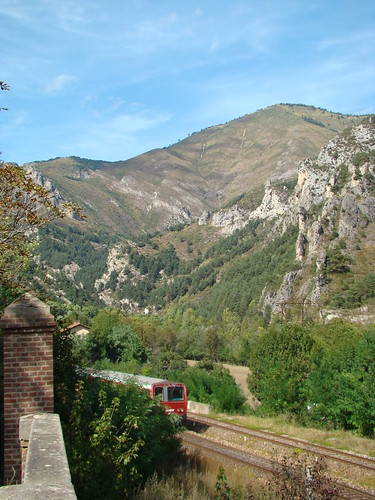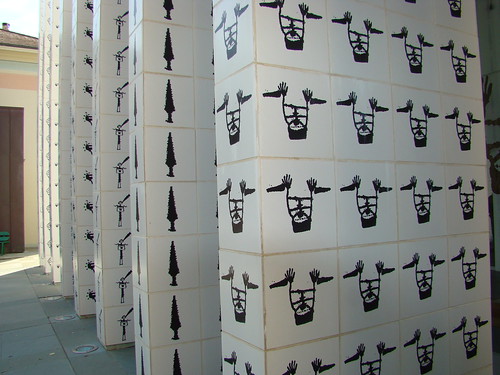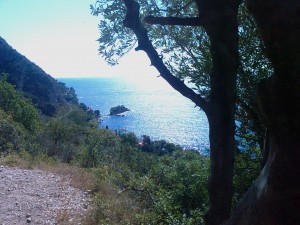Only one hour by a slow train from Vintimille, just across the border in Italy, you’re in another world – Tende, which has a very Alpine feel (it seems that everyone under the age of 60 in the town wears walking boots, and looks like they use them in anger). And the tourist office boasts pamphlets about what to do if you encounter a guard dog with its flock.

It doesn’t feel very French – perhaps not surprising since it was Italian until after the Second World War. It seems it has always been an amazing area – so close to the Med yet so cut off from the world. In the 14th century, I learnt from the display in the tourist office, muleteers brought salt trains through the valley of the Roya up to Piedemont. The Duke of Savoy, Charles-Emmanuel I, improved ties between Nice and Piedmont, allowing for other forms of transport.
But what’s really amazing about the place, and what took me there, were some 40,000 carvings, all around the tallest mount here, Mont Belgo, the bulk of them made between c 3,200 and 1700BC. That’s inspired the local “Museum of Marvels”, where most of them have been moved for safekeeping.

There’s a big, detailed display on Otzi, the Austrian ice man, who at 3,300BC almost touches on the period of the carvings. The museum isn’t big on lots of the media claims about his death, saying firmly “we have no idea about the circumstances of his death, although he did have human blood on his jacket and on the blade of his knife and and an arrow in the left shoulder” – circumstantial evidence about which a certain amount of speculation might be reasonable. What’s fascinating is how carefully tailored to their characteristics his skin clothes are. So his hat and the soles of his shoes are bearskin, loincloth and shoe uppers deer, leggings and jacket goat, and he wore a calfskin leather belt and carried a quiver of chamois strung with linden fibre. You feel that there was a reason for each of those choices. And he stood 1.6m tall and weighed about 40kg (which makes us all look pretty darned fat today – although I suppose you wouldn’t want to carry too much extra weight if you spent your life tramping around these mountains.
Then you get into the rock carvings themselves, which are spectacular, although when I look at them I was reminded of the theory about the Lascaux and similar cave paintings – that what mattered was the creation, not the actual existence of the work (quite a lot cut over the top of older work, or are created very near it but in no apparent relation to it.
I also have some problems with the interpretation of the museum. In its words: “In the early bronze age a division of labour probably led the men of the village to become responsible for the worship of the gods, hence the Mt Belgo carvings, since they visited the sacred mountains when taking their herds to alpine pastures.”
Sorry, but I really can’t see where the evidence is in this statement. Sure that’s what happened in historical times, but why assume that’s the case thousands of years before?
And there’s more. The museum identifies four types of carvings from this period: horned figures, geometric designs (identified usually with fields), anthropomorphic figures, and weapons (useful for dating by means of their shape – and the one that look remarkably like a golf flag is actually a halberd, which I will believe).
And it also suggests in at least one place that all of the figures are male. Sorry, but if you look closely at this one (which just happened to be one of the postcards I bought), this is clearly a female figure.
And you can differentiate male and female quite clear (although quite a lot have no sex organs). Now I’m not going to venture into guessing what that means, but I do think it shoots some holes in the museum interpretation.
Despite that, however, it is a very fine, fascinating display (although being quite new again plagued by the French habit of leaving you stumbling around in the dark when not immediately in front of an exhibit – and rock carvings certainly don’t need to be protected from light.)
The museum does also ventures into the ethnographic, covering the transhumance lifestyle followed until early in the 20th century. And it has the inevitable recreation of a 19th-century shepherd’s house “the walls painted blue to keep out insects”. Huh? Can anyone explain that one?
And there’s also a spookily effective mannequin with a holographic face telling old mountain stories about witches, foolish shepherds and the like, in four languages, which is rather fun…



 About
About